I'm using the go_router package in Flutter for app routing, but I'm running into issues when I use it alongside the default Flutter Appbar and Drawer widgets.
- Typical "go" and "push" methods that I'm calling from clicks in the Drawer don't work as expected when pushing the back button.
- The AppBar doesn't imply the leading back or menu behavior.
Is there something particular that needs to be done to get go_router to play nicely with the Flutter Navigator? Maybe I need to set some particular fields or a global key?
Here's what my setup looks like:
class MainApp extends ConsumerStatefulWidget {
const MainApp({Key? key}) : super(key: key);
@override
ConsumerState<MainApp> createState() => _MainAppState();
}
class _MainAppState extends ConsumerState<MainApp> {
late GoRouter router;
late Future<void> jwtInit;
@override
void initState() {
jwtInit = ref.read(jwtProvider.notifier).init();
router = GoRouter(
routes: [
GoRoute(
path: "/",
name: "home",
pageBuilder: (context, state) => MaterialPage<void>(
key: state.pageKey,
child: const HomeScreen(),
),
),
GoRoute(
path: "/settings",
name: "settings",
pageBuilder: (context, state) => MaterialPage<void>(
key: state.pageKey,
child: const SettingsScreen(),
),
),
GoRoute(
path: "/programs",
name: "programs",
pageBuilder: (context, state) => MaterialPage<void>(
key: state.pageKey,
child: const ProgramScreen(),
),
),
GoRoute(
path: "/programs/:programId",
name: "program",
pageBuilder: (context, state) => MaterialPage<void>(
key: state.pageKey,
child: ProgramDetailsScreen(
// programId: 39,
programId: int.parse(state.params["programId"]!),
),
),
),
GoRoute(
path: "/activity/:activityId",
name: "activity",
pageBuilder: (context, state) {
return MaterialPage<void>(
key: state.pageKey,
child: ActivityScreen(
id: int.parse(state.params["activityId"]!),
),
);
}),
GoRoute(
path: "/login",
name: "login",
pageBuilder: (context, state) => MaterialPage<void>(
key: state.pageKey,
child: const LoginScreen(),
),
),
],
errorPageBuilder: (context, state) => MaterialPage<void>(
key: state.pageKey,
child: const Scaffold(
body: Center(
child: Text("PAGE NOT FOUND!"),
),
),
),
// refreshListenable: api,
redirect: (context, state) {
final loggedIn = ref.read(jwtProvider.notifier).isLoggedIn;
final goingToLogin = state.location == '/login';
// the user is not logged in and not headed to /login, they need to login
if (!loggedIn && !goingToLogin) return '/login';
// the user is logged in and headed to /login, no need to login again
if (loggedIn && goingToLogin) return '/';
// no need to redirect - go to intended page
return null;
},
);
super.initState();
}
@override
Widget build(BuildContext context) {
//The reason for this FutureBuilder is to wait for the api key to
//load from storage before allowing the initial page to route. Otherwise
//the routing goes too fast and it looks logged out.
return FutureBuilder(
future: jwtInit,
builder: (context, snapshot) {
if (snapshot.connectionState == ConnectionState.done) {
//Run the UI
return MaterialApp.router(
debugShowCheckedModeBanner: false,
title: 'MyApp',
theme: MyTheme.darkTheme(context),
routeInformationProvider: router.routeInformationProvider,
routeInformationParser: router.routeInformationParser,
routerDelegate: router.routerDelegate,
);
} else {
return Container();
}
});
}
}
In my drawer, I'm calling the navigation like this:
onTap: () {
context.push("/settings");
}

